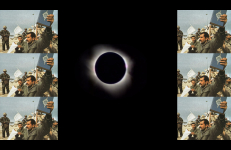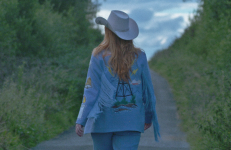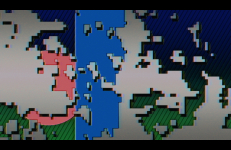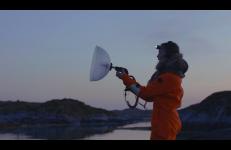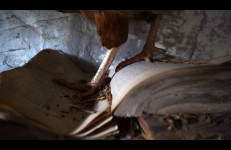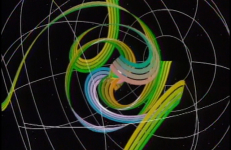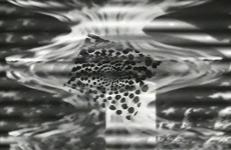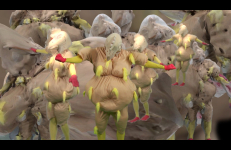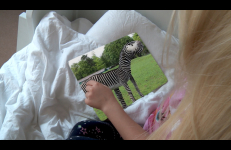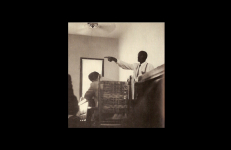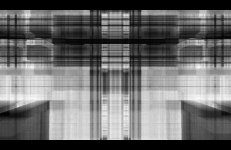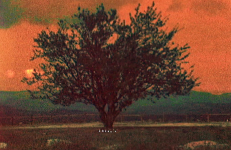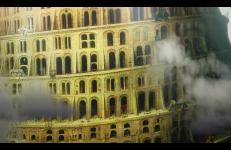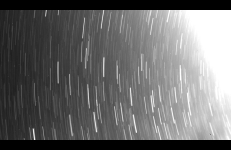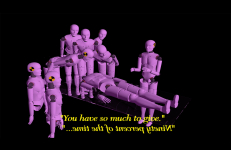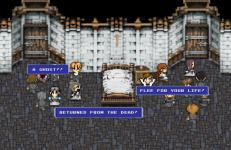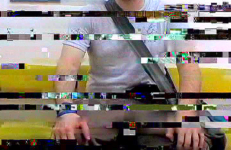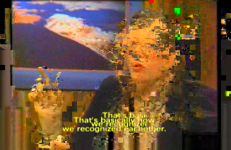Bracketed by the Fall of Berlin Wall and the Collapse of the World Trade Center, a decade that saw the ossification of the neoliberal project, the rise of third-wave feminism, the proliferation of digital media, and even, perhaps, the “end of history": postmodernism; the emergence of internet; the commercialization of gangsta rap, and independent film; AIDS activist; digital cinema; the Gulf War; rave and riot grrrl cultures; reality television; MTV. A new diagrammatic system.
Technology
2 Channel Land is a north-western docu-fiction film exploring the history of analogue signals spilling across the borders of Ireland and Britain. Guided by a mysterious threshold deity, we take a journey through Ireland's borderlands in search of community.
Images cascade and collide in Acetone Reality, as animation, found images, and the artists’ own video recordings crash against a dialogue between computer-generated voices exploring the wonders of acetone and the nature of meaning. Across Sara Magenheimer and Michael Bell-Smith’s teetering montage, blocky pixels, smeared colors, and cryptic iconography constitute an “insane, yet validated reality."
Images cascade and collide in Acetone Reality, as animation, found images, and the artists’ own video recordings crash against a dialogue between computer-generated voices exploring the wonders of acetone and the nature of meaning. Across Sara Magenheimer and Michael Bell-Smith’s teetering montage, blocky pixels, smeared colors, and cryptic iconography constitute an “insane, yet validated reality."
Located on the Lofoten Islands in Northern Norway, Acoustic Ocean sets out to explore the sonic ecology of marine life. The scientist as an explorer and important mediator of the contemporary understanding of our planetary ecosystems is a central figure in this video. She makes her appearance in the person of a Sami (indigenous of northern Scandinavia) biologist-diver who is using all sorts of hydrophones, parabolic mics and recording devices. Her task is to sense the submarine space for acoustic and other biological forms of expression.
Within a backdrop of the natural world, a woman explores a personal relationship with the home artificial intelligence (AI) device, Alexa.
AI and I asks questions as to the nature of what it is to be alive and human, confronting our complex co-dependence with technology.
Computer graphics by Dan Sandin and colleagues.
Concept by George Francis, Louis Kauffman, Dan Sandin
Computer graphics by Chris Hartman, John Hart –Dance: Jan Heyn Cubacub
Edited by Dana Plepys
Music by Sumit Das
“Mining an ironic vein by turning technology against itself, AlienNATION undercuts the sociological ramifications of modern living. It is an astounding compendium of sci-fi images, textbook diagrams, special effects, and studio props, which together build multiple readings of the alien, the mysterious, and the obscure in American culture.
“Mining an ironic vein by turning technology against itself, AlienNATION undercuts the sociological ramifications of modern living. It is an astounding compendium of sci-fi images, textbook diagrams, special effects, and studio props, which together build multiple readings of the alien, the mysterious, and the obscure in American culture.
“Mining an ironic vein by turning technology against itself, AlienNATION undercuts the sociological ramifications of modern living. It is an astounding compendium of sci-fi images, textbook diagrams, special effects, and studio props, which together build multiple readings of the alien, the mysterious, and the obscure in American culture.
“All that is solid melts into air, all that is holy is profaned, and man is at last compelled to face with sober senses his real conditions of life, and his relations with his kind.”
— Karl Marx and Friedrich Engels, The Communist Manifesto, 1848
Two bizarrely costumed characters – a human ‘chicken’ in a fat suit, and an elaborate folksy creature called an ‘authenticity fetish’- meet and debate their plight. In an attempt to reconcile themselves with some unspecified trauma of mass biotechnoviolation, these two beings quiz one another in rhyme and animation on the origins and ontologies of their species. A sardonic meditation on the nefarious reality of intensive farming, Artificial Intelligence, and the perils of denying complexity.
Two characters speak urgently to camera about their relationship with an intelligent substance they call ‘Animal Expanded’. The man has swallowed it, as he expands it impregnates his home, improving his family. He holds his five-year-old up to camera: “Look how her fibers are formatting - she is her very own accelerated portfolio!” The woman has refused – "it’s not alive in the right way". For this disobedience she is punished with Confusion Events. But in her studio she is building new weapons, bizarre kinetic sculptures that she believes will "Re-align the narrative centre".
Animated Contingencies is an animated documentary that looks at how sketches take the place of photography in courtroom settings. Andrews focuses on how two different representations, a photograph and a courtroom sketch, capture the moment Moses Wright, Emmett Till's uncle, pointed out Till's murders while on the witness stand at their trial. The work then examines the authority of photographic evidence and how animated representations can provide both visibility and anonymity in testimony and other contexts.
Archives recovers the formal community that mobilizes the diagrammatic experience of archives, a formal community that claims the sensory nucleus where hypertrophic rhythms, abstract machines, monuments and memorials, digital servers, corporate architecture, traffic and computer flows, light brutalisms, digital gadgets, detention camps, prisons and hospitals, institutes and academies, universities and housing all integrated in the rhythmic and diagrammatic outburst of the archives.
From the south of France, a science fiction film about the end of the Leisure Class and that which came to replace it.
From the south of France, a science fiction film about the end of the Leisure Class and that which came to replace it.
Babeldom is a city so massive and growing at such a speed that soon, it is said, light itself will not escape its gravitational pull. How can two lovers communicate, one from inside the city and one outside? This is an elegy to urban life, against the backdrop of a city of the future, a portrait assembled from film shot in modern cities all around the world and collected from the most recent research in science, technology and architecture.
"It’s a complex architectural vision equal parts awesome and terrifying… This is a film – and city – to get lost in."
In a city post-apocalypse, young men communicate only through smart devices. They make home out of urban debris. They can’t speak to each other, but are still able to dream.
Black Rain is sourced from images collected by the twin satellite, solar mission, STEREO. Here we see the HI (Heliospheric Imager) visual data as it tracks interplanetary space for solar wind and CME's (coronal mass ejections) heading towards Earth.
Zach Blas is an artist, writer, and filmmaker whose practice spans technical investigation, research, conceptualism, performance, and science fiction. Currently a Lecturer in the Department of Visual Cultures at Goldsmiths, University of London, Blas has exhibited internationally, including at the Walker Art Center, Gwangju Biennale, Los Angeles County Museum of Art, and Whitechapel Gallery.
In part a remake of Hollis Frampton’s Gloria! (1979), in part a repurposing of hacked, 16-bit video game technology, The Well of Representation asks us to reconsider our fear of the liminal. Following the convergent narratives of several voices, ranging from the linearly historical to the cybernetically personal, we come to understand the journey ahead: searching from interface to interface, knowing that whatever home we find will be a collaborative compromise. One where we might live beyond our representations and finally come to say what we mean.
Fashioned out of home movies recovered from failing hard drives, this glitch-art video makes comparisons between different forms of memory - suggesting that, while error and decay may keep us up at night, they might also be the way we put our ghosts to bed.
-- Evan Meaney
We have come to this place of meaning together, celebrating our un-remaindered completeness. Yet, in our wake endures a long procession of stowaways: misspoken sounds we unconsciously omit, the limitations of our alphabet, the ignored gaps of an imperfect analog, and most recently, these forgetful bits of the virtual. We celebrate the lineage of our information as we celebrate one another, not realizing that the loudest affirmations might come from these unacknowledged, unavoidable participants. With each generation, they say a little bit more, speaking a little bit louder.




